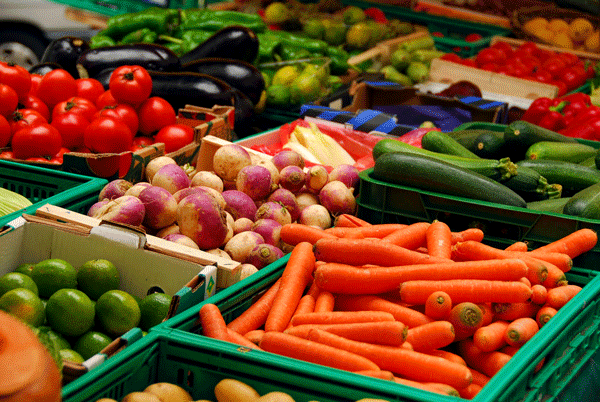Udupi: Prices of Vegetables, Fruits Doubled; Housewives Struggle at Difficult Times
By Snehalatha, Udupi
Bellevision Media Network
Udupi, 31 May 2013 : The common-folks were happy because of gold prices have come down, but gets a shock to know the hike in prices of fruits and vegetables that are essential for daily living.
The low-yield of vegetable crops owing to insufficient rains led to hike in its prices, while on the other hand the demand for vegetables and fruits are doubled owing to auspicious celebrations ahead of monsoon season, which has forced the greedy merchants to hike the prices.






The hosts who will have to entertain the guests with sumptuous food had to buy vegetables whatever the rate the merchant quotes. The nexus of merchants, middlemen work closely to exploit the situation owing to which the prices of fruits and vegetables have nearly trebled.
The beans that was sold for Rs 1,800 per quintal during January in the vegetable market here increased to Rs 4,200 in May. Carrot that was sold for Rs 1,800 per quintal is sold for Rs 4,500. The lentil that was sold for Rs 1,800 per quintal is sold for Rs 5,200. Tomato that was sold for Rs 1,200 per quintal is sold for Rs 2,200, similarly the prices of spinach, beetroot, cabbage, etc are nearly doubled.
The prices of fruits also nearly doubled, the apples that was sold for Rs 10,500 per quintal is sold for Rs 13,500. The grapes that was sold for Rs 3,300 is sold for Rs 4,300. The oranges that was sold for Rs 2,200 is sold for Rs 4,700, similarly the prices of rest of the fruits also nearly doubled.
The prices of pulses and grains also hiked, the toor dal that was sold for Rs 4,300 about 4 months ago now sold for Rs 4,500, green peas and coriander prices stands at Rs 5,800 and Rs 10,500 respectively. The prices of onion, garlic, rice, paddy, maize, wheat, jaggery etc also hiked. The chilly price is too dear for common-folks like rare spice.
The customers hope the prices will be stabilized after the auspicious season comes to an end and the demand for vegetables subsides. Meanwhile, it’s a challenge to housewife to balance her budget if the monsoon becomes erratic and the prices of vegetables do not subside.
Ginger - the most expensive:
Although the prices of vegetables, fruits and leafy vegetables hiked, the price of ginger has skyrocketed. The price of ginger is further rising, despite slash in price of gold. The price of ginger during January was Rs 2,600, Rs 2,900 in February, Rs 3,200 in March, Rs 6,700 in April and in May it is Rs 10,200 per quintal. It’s fortunate that one does not need ginger in huge quantities like the vegetables!!!
 Write Comment |
Write Comment |  E-Mail To a Friend |
E-Mail To a Friend |
 Facebook |
Facebook |
 Twitter |
Twitter |
 Print
Print | Comments on this Article | |
| Philip Mudartha, Navi Mumbai | Fri, May-31-2013, 5:45 |
| A week ago, I met a Sanpada fruit wholesale dealer living in Nerul. Summery: 1. The main distributor charges Rs 22 per piece, allowing Rs 4 for local transporter and sub-distributors(tempo-owners)to split. 2. He is supplied by a main distributor based in Mysore, who charges Rs.16-17. 3. The Mysore distributor pays Re.1 as agent commissions, who collect the nut from farms to their katte, and pay the farmers RS 10, rate fixed by Coconut Development Board. 4. He also pays the main transporter in Mandya/Mysore, who contracts and delivers by truckloads over 800 kms to Navi Mumbai. The transport cost will be Rs. 2-3, allowing Mysore dealer with Rs 3 in profits. The value chain for fruits, vegetables, mallige and areca-nut etc is similar. Everyone makes a living and wonders he gets least. I think free market is a fair mechanism, where a competition keeps a balance and remedies a situation where someone is greedy. The only parasites in the chain is the hafta collectors in Mumbai, who take advantage of self-employed small traders, who do not have the capacity to rent business outlets and are forced to hawk in public places and causing nuisance to pedestrians. They must be shot? | |
| Philip Mudartha, Navi Mumbai | Fri, May-31-2013, 2:56 |
| Yesterday, from dawn to dusk in a span of twelve hours, I quenched my thirst with tender coconut water three times. I traversed 200 square kilometers of Greater Mumbai and talked to three hawkers, all from Kerala. The summery: 1. The lorry supplies them at Rs.26 a piece. 2. They segregate the lot into very tender (no malai, all water, not so sweet), tender (malai forming, sweet water) and regular (malai formed, less water, very sweet). One needs skill to identify before selecting according to the customer demand. 3. They charge Rs. 30 and Rs. 35, according to category. Average sales price is Rs.32 a piece. 4. The street vendor makes Rs.6 per piece. if he is lucky to sell 200 each day, he makes Rs.1200. 5. all three declined to tell me the amount of hafta required to keep local hawaldar, goonda, and municipal clerk, and leader s chela satisfied enough to permit him run the street corner business. From my studies in this city, the expense is about 50% of daily picking, leaving the vendor with Rs. 3 per piece. That is 11.5% profit margin on gross sales. Surely, it does not fall in greed category. 4. The lorry picked them up from wholesale dealer based in Sanpada, Navi Mumbai. Contd | |



















